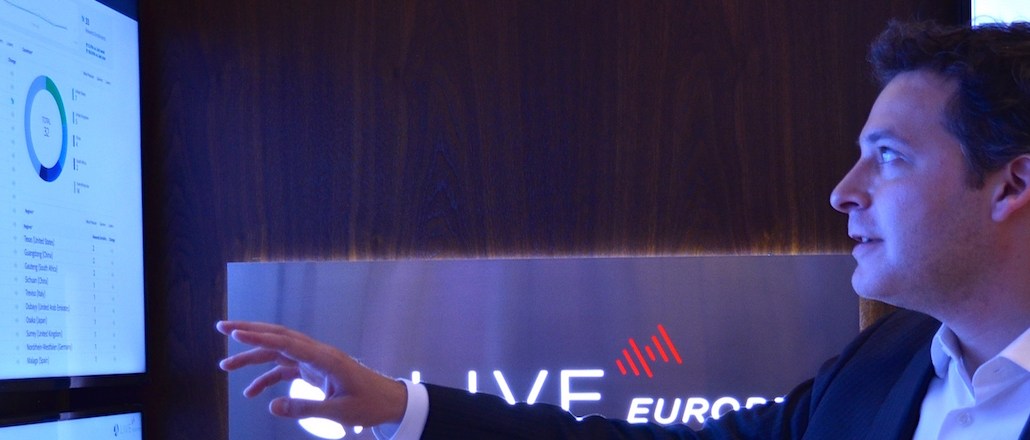
The once-ubiquitous social media “war rooms” that sprung up around big events like the Super Bowl are becoming a thing of the past. Instead, brands are now battling to make sense of real-time data on a daily basis — not just the big occasions. Last week, Marriott brought its fight to Europe.
At its European headquarters in London, the hotel group has launched its fourth “M Live” social media command center. It follows U.S. hubs in Maryland and Florida, and another in Hong Kong. By the time its final center opens in Dubai next year, the group will have all time zones covered.
As with Marriott’s other full-time war rooms, its London team — two content producers, a data analyst and a graphic designer — will sit above the social channels of its 19 different hotel brands. From here, they serve three functions: identifying trends, creating ad-hoc content and cross-pollinating content across Marriott’s different brand channels. As a kind of all-seeing eye, this involves sifting through a “firehose” of data from internal and external sources: Anything from the most popular emojis in use on its properties to uncovering trending topics on Reddit.
The room is also looped in to real-time results. For example, a page showing the number of sign-ups to its Marriott Rewards program. Further down the line, Marriott will roll out specific dashboards that show a direct correlation between content and bookings.

“Before, we were all waiting to see a campaign was effective and we’d get a report two weeks later. By that time, everyone has moved on to the next assignment, and it’s left forgotten,” explained Matthew Glick, Marriott International’s senior director of global creative and content marketing, who jumped ship from CBS last year.
Thanks to M Live, Marriott has been able to jump on trending content and tweak existing campaigns within hours. Its impromptu activity around the #RunningMan challenge, for example, garnered over 62,000 views for the Renaissance hotel. Meanwhile, its Global Day of Discovery, which saw Renaissance hotels share content, racked up 48.5 million Twitter impressions.
Marriott’s geo-location capability lets the hotel group track all social posts from within its near-4,500 properties worldwide via tech from Hyp3r. During its Day of Discovery, its Renaissance hotels saw a 420 percent increase in Instagram conversation after using the tool.
“All our brand channels have content seeding on a daily basis — like a flashlight going on and off — but we can turn on those flashlights at same time to form a beam of light. It cuts through the noise for no paid spend,” Glick said.

But London won’t be a carbon copy of its other hubs in this hub-and-spoke model. Unlike Marriott’s other studios, London will have the added challenge of engaging in multiple languages. Thankfully, its two content producers are multilingual, while its social teams are native speakers in their regions.
After Glick flies home to D.C., he’ll leave behind giant binders filled with flow charts that outline how the team should approach different scenarios as they arise online. For example, flagging an issue with Marriott’s separate crisis management team. But while there are many (rather ironic) formulas for spontaneity, they only go so far.
“We want them to be empowered enough to pivot on a specific trend, as opposed to it coming from corporate. You’ve gotta build these things out in regions so they can be flexible,” he said.
The big prize for Marriott in this quest to be “always on” is the next generation of travelers, aka millennials. Part of the group’s shift to becoming a media company (though Glick wouldn’t use that word outright) was to follow younger users onto non-traditional channels.

“With the next generation of travelers, you can’t force it, you can’t be sales-y about it. It can’t be heavily branded,” Glick said. “We’ve bent over backwards for it to be fun and engaging without the promotions plastered all over the place.” According to Glick, Marriott frequently passes on viral content because of the knowledge the brand would get called out for it on social.
Another part of Marriott’s drive to bring its content in-house has been cutting costs. So far the project has cost the same as what Marriott was spending on agencies beforehand. In that sense, it’s not a big investment for the company. Also, it frees up the budget to work with the Silicon Valley startups like Hyp3r.
The group still has a huge portfolio of media properties, including a marquee on Times Square. It still works with MEC, its media agency, to amplify successful campaigns for added impact.
“It’s much more efficient to have your own experts in the media sphere and the social sphere living and breathing
More in Media

Digiday+ Research: Publishers’ growing focus on video doesn’t translate to social platforms
Major publishers have made recent investments in vertical video, but that shift is not carrying over to social media platforms.

Technology x humanity: A conversation with Dayforce’s Amy Capellanti-Wolf
Capellanti-Wolf shared insight on everything from navigating AI adoption and combating burnout to rethinking talent strategies.

How The Arena Group is rewriting its commercial playbook for the zero-click era
The company is testing AI-powered content recommendation models to keep readers moving through its network of sites and, in doing so, bump up revenue per session – its core performance metric.





